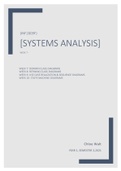Summary
Summary INF2009F complex diagrams: theory and drawing guidelines
- Institution
- University Of Cape Town (UCT)
This document unpacks the theory and drawing guidelines of domain class diagrams, class diagrams, use case realisation, sequence diagrams and state machine diagrams.
[Show more]



